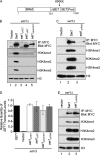Charge-based interaction conserved within histone H3 lysine 4 (H3K4) methyltransferase complexes is needed for protein stability, histone methylation, and gene expression
- PMID: 22147691
- PMCID: PMC3268424
- DOI: 10.1074/jbc.M111.280867
Charge-based interaction conserved within histone H3 lysine 4 (H3K4) methyltransferase complexes is needed for protein stability, histone methylation, and gene expression
Abstract
Histone H3 lysine 4 (H3K4) methyltransferases are conserved from yeast to humans, assemble in multisubunit complexes, and are needed to regulate gene expression. The yeast H3K4 methyltransferase complex, Set1 complex or complex of proteins associated with Set1 (COMPASS), consists of Set1 and conserved Set1-associated proteins: Swd1, Swd2, Swd3, Spp1, Bre2, Sdc1, and Shg1. The removal of the WD40 domain-containing subunits Swd1 and Swd3 leads to a loss of Set1 protein and consequently a complete loss of H3K4 methylation. However, until now, how these WD40 domain-containing proteins interact with Set1 and contribute to the stability of Set1 and H3K4 methylation has not been determined. In this study, we identified small basic and acidic patches that mediate protein interactions between the C terminus of Swd1 and the nSET domain of Set1. Absence of either the basic or acidic patches of Set1 and Swd1, respectively, disrupts the interaction between Set1 and Swd1, diminishes Set1 protein levels, and abolishes H3K4 methylation. Moreover, these basic and acidic patches are also important for cell growth, telomere silencing, and gene expression. We also show that the basic and acidic patches of Set1 and Swd1 are conserved in their human counterparts SET1A/B and RBBP5, respectively, and are needed for the protein interaction between SET1A and RBBP5. Therefore, this charge-based interaction is likely important for maintaining the protein stability of the human SET1A/B methyltransferase complexes so that proper H3K4 methylation, cell growth, and gene expression can also occur in mammals.
Figures









Similar articles
-
A conserved interaction between the SDI domain of Bre2 and the Dpy-30 domain of Sdc1 is required for histone methylation and gene expression.J Biol Chem. 2010 Jan 1;285(1):595-607. doi: 10.1074/jbc.M109.042697. Epub 2009 Nov 6. J Biol Chem. 2010. PMID: 19897479 Free PMC article.
-
Protein interactions within the Set1 complex and their roles in the regulation of histone 3 lysine 4 methylation.J Biol Chem. 2006 Nov 17;281(46):35404-12. doi: 10.1074/jbc.M603099200. Epub 2006 Aug 18. J Biol Chem. 2006. PMID: 16921172
-
Distinct requirements for the COMPASS core subunits Set1, Swd1, and Swd3 during meiosis in the budding yeast Saccharomyces cerevisiae.G3 (Bethesda). 2021 Oct 19;11(11):jkab283. doi: 10.1093/g3journal/jkab283. G3 (Bethesda). 2021. PMID: 34849786 Free PMC article.
-
Spp1 at the crossroads of H3K4me3 regulation and meiotic recombination.Epigenetics. 2013 Apr;8(4):355-60. doi: 10.4161/epi.24295. Epub 2013 Mar 19. Epigenetics. 2013. PMID: 23511748 Free PMC article. Review.
-
Diverse and dynamic forms of gene regulation by the S. cerevisiae histone methyltransferase Set1.Curr Genet. 2023 Jun;69(2-3):91-114. doi: 10.1007/s00294-023-01265-3. Epub 2023 Mar 31. Curr Genet. 2023. PMID: 37000206 Review.
Cited by
-
Stepping inside the realm of epigenetic modifiers.Biomol Concepts. 2015 Apr;6(2):119-36. doi: 10.1515/bmc-2015-0008. Biomol Concepts. 2015. PMID: 25915083 Free PMC article. Review.
-
Targeted Disruption of the Interaction between WD-40 Repeat Protein 5 (WDR5) and Mixed Lineage Leukemia (MLL)/SET1 Family Proteins Specifically Inhibits MLL1 and SETd1A Methyltransferase Complexes.J Biol Chem. 2016 Oct 21;291(43):22357-22372. doi: 10.1074/jbc.M116.752626. Epub 2016 Aug 25. J Biol Chem. 2016. PMID: 27563068 Free PMC article.
-
Positive regulation of the Candida albicans multidrug efflux pump Cdr1p function by phosphorylation of its N-terminal extension.J Antimicrob Chemother. 2016 Nov;71(11):3125-3134. doi: 10.1093/jac/dkw252. Epub 2016 Jul 7. J Antimicrob Chemother. 2016. PMID: 27402010 Free PMC article.
-
Catalytic and functional roles of conserved amino acids in the SET domain of the S. cerevisiae lysine methyltransferase Set1.PLoS One. 2013;8(3):e57974. doi: 10.1371/journal.pone.0057974. Epub 2013 Mar 1. PLoS One. 2013. PMID: 23469257 Free PMC article.
-
Assembling a COMPASS.Epigenetics. 2013 Apr;8(4):349-54. doi: 10.4161/epi.24177. Epub 2013 Mar 7. Epigenetics. 2013. PMID: 23470558 Free PMC article.
References
-
- Dehé P. M., Dichtl B., Schaft D., Roguev A., Pamblanco M., Lebrun R., Rodríguez-Gil A., Mkandawire M., Landsberg K., Shevchenko A., Shevchenko A., Rosaleny L. E., Tordera V., Chávez S., Stewart A. F., Géli V. (2006) Protein interactions within the Set1 complex and their roles in the regulation of histone 3 lysine 4 methylation. J. Biol. Chem. 281, 35404–35412 - PubMed
-
- Steward M. M., Lee J. S., O'Donovan A., Wyatt M., Bernstein B. E., Shilatifard A. (2006) Molecular regulation of H3K4 trimethylation by ASH2L, a shared subunit of MLL complexes. Nat. Struct. Mol. Biol. 13, 852–854 - PubMed
Publication types
MeSH terms
Substances
Grants and funding
LinkOut - more resources
Full Text Sources
Molecular Biology Databases
Research Materials
Miscellaneous

